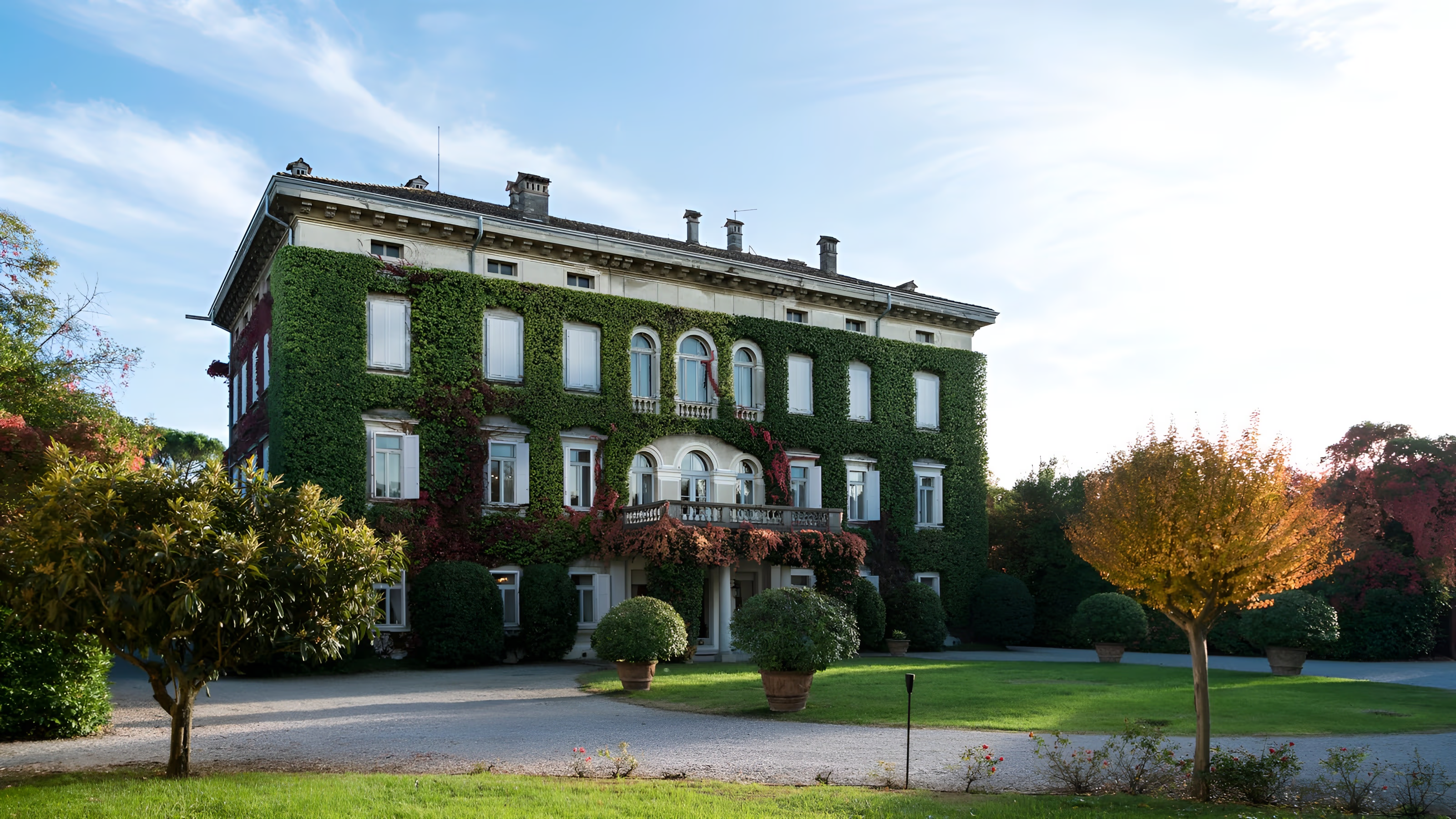The Counts of Angoris and the Agricultural Economy
History and Legacy of the Angoris Estate
The history of the Angoris estate has deep roots dating back to the 17th century, precisely February 7, 1647, when the Austrian Emperor Ferdinand III granted 300 fields to Baron Locatello Locatelli.
This grant was in recognition of his eighteen years of military service during the bloody Thirty Years’ War, which ended with the Peace of Westphalia in 1648. The lands, situated in the fertile area called Langoris — renamed Angoris in 1923 — became the foundation for one of the region’s most important estates.
The villa, likely built between the late 1600s and early 1700s, played a crucial role during World War I, when it was requisitioned by the Italian army and transformed into a large military hospital for the wounded from the Isonzo front.
The land behind it became a cemetery where about 1,500 soldiers were buried; their remains were later moved to the Redipuglia memorial at the end of the conflict.
During the 20th century, the property passed through various hands until it came in 1939 to the Sacta company, owned by the Miani Counts — Friulian nobility and influential industrialists in the petroleum sector.
In the 1950s, Count Miani revolutionized the estate by being the first in Cormons to bottle quality wines, establishing a thoroughbred horse breeding program, and planting new orchards.
It all began with Locatello Locatelli, an Austrian colonel and heroic figure of the Thirty Years’ War, whose intense gaze and playful locks are immortalized in a 17th-century engraving.
Beneath his portrait is an enduring motto: “Di ben in meglio” (From good to better).
Originating from a Bergamo family, Locatello was awarded the 300 fields in the fertile Cormons area by the emperor, marking the birth of the extraordinary Langoris estate — later renamed Angoris.
Among many fascinating details, Luigi Miani was a witness at the “wedding of the century” in 1949 between Tyrone Power and Linda Christian.
Thanks to him, the Italo-American film crew of “A Farewell to Arms,” including stars like Rock Hudson and Alberto Sordi, arrived in Friuli. A passionate horse breeder, he created a stud farm where the legendary stallion Ribot spent his retirement years.
Stefano Cosma’s book, produced with the collaboration of the Locatelli family, guides readers through a journey filled with encounters, personalities, and revelations about the great wines born in this land, enriched by archival images and a classic plot twist.
As Alessandro Marzo Magno highlights in the preface, this story must be told by tracing hidden streams and folds of time, to finally understand how the skillful Locatello Locatelli was truly right: at Angoris, always “from good to better.”
Angoris stands as a unique place — a captivating chapter in history linked to the countryside, the production of fine wines, agricultural experiments, and horse breeding. Notable figures have passed through here: Angoris even hosted a small zoo, whose king was a lion named Dolfo, pictured peacefully resting surrounded by the affection of his keepers. For literary gossip enthusiasts, it is said that Ernest Hemingway once visited the estate while the “A Farewell to Arms” crew was staying there.
Moreover, among the distinguished guests recorded in archives are Emperor Franz Joseph, who alighted at the Cormons train station, and King Victor Emmanuel III, who visited the hospital during the war.
Photographs from the 1960s show President Giuseppe Saragat and Giulio Andreotti. These images, differing in era and tone, narrate how the world changed over time.
To dive into this fascinating universe, full of surprises and intertwined realities and fantasies, a must-read book is available, published by Leg Editrice of Gorizia and presented at Pordenonelegge: “Langoris. Stories of Wines and Knights.” Cosma recounts the 370 years of Angoris through the voice of Carlotta, a Red Cross nurse in 1917 who returns as an elderly woman in 1968, the year the estate was acquired by Knight of Labor Giulio Locatelli, an industrialist from Pordenone and founder of major companies.
Finally, it should be noted that Angoris, founded by a Locatelli military leader, later returned to another Locatelli family, not related to the previous dynasty.
In between, a fundamental chapter was the era of Count Luigi Miani, originally from Martignacco, a wealthy oilman integrated in the Roman and international jet set, where Angelo Moratti also trained.
Ownership by the Miani Counts
At the beginning of the 1900s, the land where La Faula sits was owned by the Miani Counts of Angoris. The Tenuta d'Angoris, just outside Cormons, remains a renowned agricultural estate, particularly famous for its wines.
The properties of the Counts of Angoris were held through a company called SACTA – Società Anonima Conduzione e Trasformazioni Agricole based in Venice. Despite their agricultural involvement, the Counts' principal income came from oil trading in Rome.
One of their notable properties in the capital, Villa Miani, still stands as a landmark on Via Trionfale.
Innovative Agricultural Endeavors
In the 1950s, Count Luigi Miani was among the first to bottle quality wines in the D.O.C. Collio area, gaining fame nationally and internationally. He was also a passionate horse breeder and invested in extensive peach orchards near Mariano and Gradisca.
His focus on early-ripening varieties made his produce highly sought after.
In 1940, Count Miani married Yolande Beatrix de Dampierre, from the princely Ruspoli family of Florence. Together, they had a son named Alexis.
Construction of the Sharecropper's House
Around 1910, Count Miani commissioned the construction of a house at La Faula for a sharecropping family.
Poor locals from Ravosa helped with construction: clearing stumps, digging foundations, transporting materials in shoulder-carried baskets (called cosse in Friulian), and squaring stones from local quarries—all in exchange for stumps and some cash.
The house was built in three stages, beginning with the western wing. Villagers also cleared the surrounding hill by hand to prepare it for cultivation.
Contrary to today, the hill had hardly any trees at that time.
The Nicoletti and Marano Families
Of the first tenant family, the Nicoletti, nothing is known. In 1929, Pietro Marano from Trivignano Udinese, ruined by the global financial crash, arrived with his wife Erminia and six children.
Though his stay was brief, he co-managed La Faula with the incoming Basso Family before moving to Segnacco.
Sadly, in 1945, two of Pietro’s sons were ambushed during a delivery by retreating German troops. One died and another was left permanently disabled.
The Basso Family: Agricultural Transformation
In 1930, five Basso brothers — Mario, Amedeo, Piero, Gelindo, and Giovanni — settled at La Faula.
They planted orchards (peach, apple, cherry), cultivated cereals and grapes, raised cows and pigs, and even bred silkworms. Each vineyard (or ronc) had its own name based on geography or usage.
The family produced roughly 1,500 liters of wine annually.
Their farming was traditional, using cows for ploughing and hand tools for most work. Milk was delivered to the local dairy.
Fruit was highly regulated: only damaged produce could be consumed by the family.
Rent to the Counts consisted of half the wine produced, plus cash.
Daily Life and Education
The family slept divided by gender in separate rooms.
Water came from springs, and a ford or swing-bridge crossed the Malina until the 1960s.
Electricity arrived after WWII.
The children walked several kilometers to attend schools in Ravosa, Magredis, and Savorgnano.
Women washed clothes in the river and cooked meals, often using ash for laundry.
The cow stall was the warmest place and served as a communal space for reading and singing.
Instruments like the guitar enlivened Sundays, while village dances took place at Ravosa’s now-defunct dance hall.
The Final Years of Sharecropping
The Basso brothers gradually left La Faula between the 1940s and 1958.
Mario remained the longest.
His daughter Miranda later recounted these memories in detail, including the family’s desire to buy the property — which they could not afford.
After the Basso family, several tenants followed, including a psychiatric hospital administrator and the Colautti Family.
The idea of subdividing La Faula into lots emerged but proved geologically unsound due to the clay terrain.
The Decline of the Miani Counts and End of an Era
The Counts of Angoris eventually mortgaged the estate. In 1967, Franco Colautti bought La Faula for 9 million lire, marking the end of the Miani era.
This purchase was the beginning of a new chapter — one tied to modern reconstruction, but deeply rooted in the agricultural and social history forged under the Counts' ownership.
Additional Information by turismofvg.it
Villa Locatelli is the historic residence that has been located in the center of the Tenuta di Angoris since the beginning of the 18th century.
It is a precious witness and guardian of the past of this land and of the men who lived and worked here, writing its history.
Surrounded and protected by a centuries-old park, it is admirable among the ever-bright colors that surround it and the pure white of its walls like taking a walk through time.
Among its trees you can find the scents of the four seasons and of the air.
The red spring roses of the entrance avenue or the colored leaves of autumn and the scents of the grape harvest, perhaps sitting at the piano that once belonged to the Barons Locatelli or among the books of the ancient library, are some of the details that will make your event unique.
The villa is further embellished by a small consecrated extra-oppida church, a true jewel of the 18th century.


